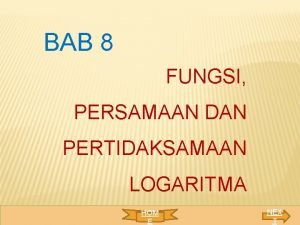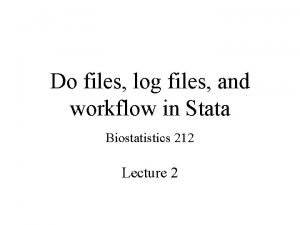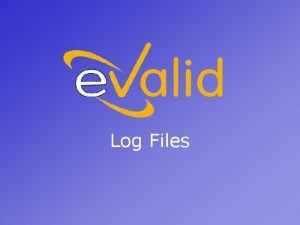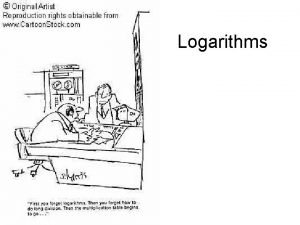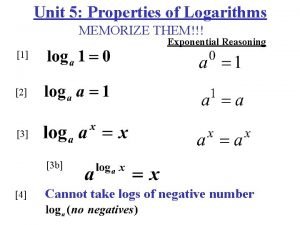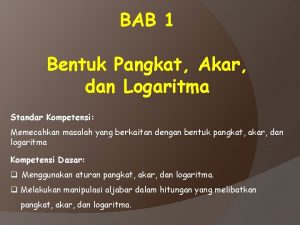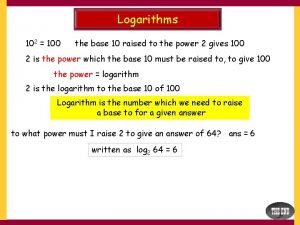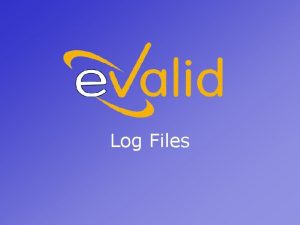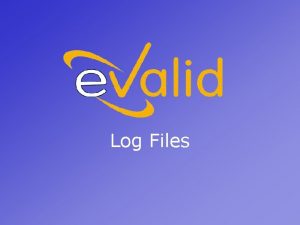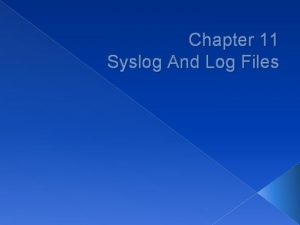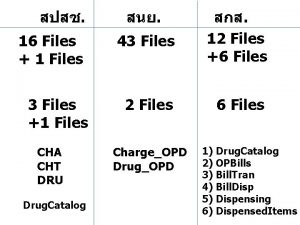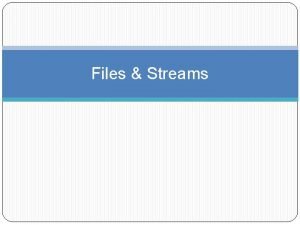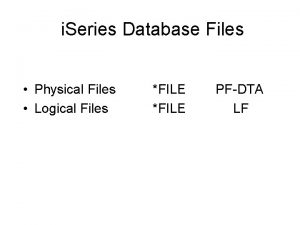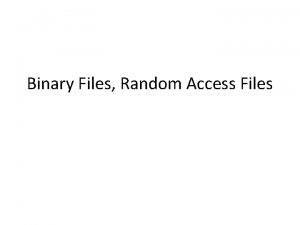Log Files e Valid Log Files e Valid


















- Slides: 18

Log Files

e. Valid Log Files e. Valid validates your Web. Site by recognizing and recording both successful and unsuccessful events. Detailed records are stored in its Log Files.

e. Valid: Creating Log Files Step 1 of 9 There are three logging methods that can be set from the Settings > Record/Play Preferences.

e. Valid: Logging Methods Step 2 of 9 In the Project/Log Management settings screen, click on the Logging you prefer: . : Simple. : Standard. : Detailed

e. Valid Log Files: Start Recording Step 3 of 9 In the address bar, type the URL of the Web. Site you want to test. Then, Start Recording all the pages you wish to analyze.

e. Valid Log Files: Stop Recording Step 4 of 9 From the pulldown menu, select Stop Recording when you are satisfied with the event.

e. Valid Log Files: Start Playback Step 5 of 8 Hitting Playback > Start Playback will report all the movement, steps and mouse clicks you executed.

Viewing e. Valid Log Files Step 6 of 9 The Event Log contains all events that occurred during script playback. To view the Event Log, select Window > Logs Event Log.

e. Valid Log Files: Simple Method Step 7 of 9 The Event Log is shown here using a Simple logging format, as set in Step 2.

e. Valid Log Files: Standard Method The Event Log is shown here using a Standard logging format, as set in Step 2.

e. Valid Log Files: Cache Manager If you desire to use Detailed logging, make sure that Never Use Cache is selected from Settings > Cache Manager before running the playback with detailed logs.

e. Valid Log Files: Detailed Method The Event Log is shown here using a Detailed logging format, as set in Step 2.

e. Valid Log Files: Select Your Format Step 8 of 9 For a quick result check, click on View > Icon in the upper left of the log file. Choose from different log formats: View all data as Java Applet Graph. View data from a Spread sheet. View data as HTML Table.

e. Valid Log Files: Log Graphs Step 9 of 9 For more detailed results, use the log files to generate graphical output. Select Window > Graphs > Log Graphs.

e. Valid Log Files: Chart Selection On the resulting page, select the graphical chart you are looking for.

e. Valid Log Files: Chart Sample A sample of the color -coded Performance Chart is shown on the left, with detailed download times from the last playback.

e. Valid Log Files: Chart Descriptions A detailed explanation of each dynamic analysis Chart can be accessed by clicking the Explanation link.

e. Valid Log Files: Explanation Sample A sample of the chart explanation is shown on the left. It gives detailed analysis of the download times for the web pages you tested.
 Dot powai files are binary files
Dot powai files are binary files Cjis security awareness
Cjis security awareness Ncic hosts restricted files and non-restricted files
Ncic hosts restricted files and non-restricted files Log 3=0 477 dan log 2=0 301 nilai log 18=
Log 3=0 477 dan log 2=0 301 nilai log 18= Sifat sifat logaritma
Sifat sifat logaritma Selesaikan persamaan eksponen 3ˣ = 81 adalah
Selesaikan persamaan eksponen 3ˣ = 81 adalah 1 + 3,3 log 80
1 + 3,3 log 80 Jika panjang ap 8 cm bq 5 cm
Jika panjang ap 8 cm bq 5 cm Log 3=0 477 dan log 2=0 301 nilai log 18=
Log 3=0 477 dan log 2=0 301 nilai log 18= Materi persamaan dan pertidaksamaan logaritma
Materi persamaan dan pertidaksamaan logaritma Jika log 5 = 0 699 nilai log 20 adalah
Jika log 5 = 0 699 nilai log 20 adalah Save log stata
Save log stata Select the valid log manager
Select the valid log manager How do you get rid of ln
How do you get rid of ln Power law log log plot
Power law log log plot Logarithmic rules
Logarithmic rules Pengertian pangkat, akar dan logaritma
Pengertian pangkat, akar dan logaritma Exponential transformation
Exponential transformation Log m - log n
Log m - log n









